BMW 540I SEDAN 2000 Owners Manual
Manufacturer: BMW, Model Year: 2000, Model line: 540I SEDAN, Model: BMW 540I SEDAN 2000Pages: 217, PDF Size: 1.69 MB
Page 181 of 217
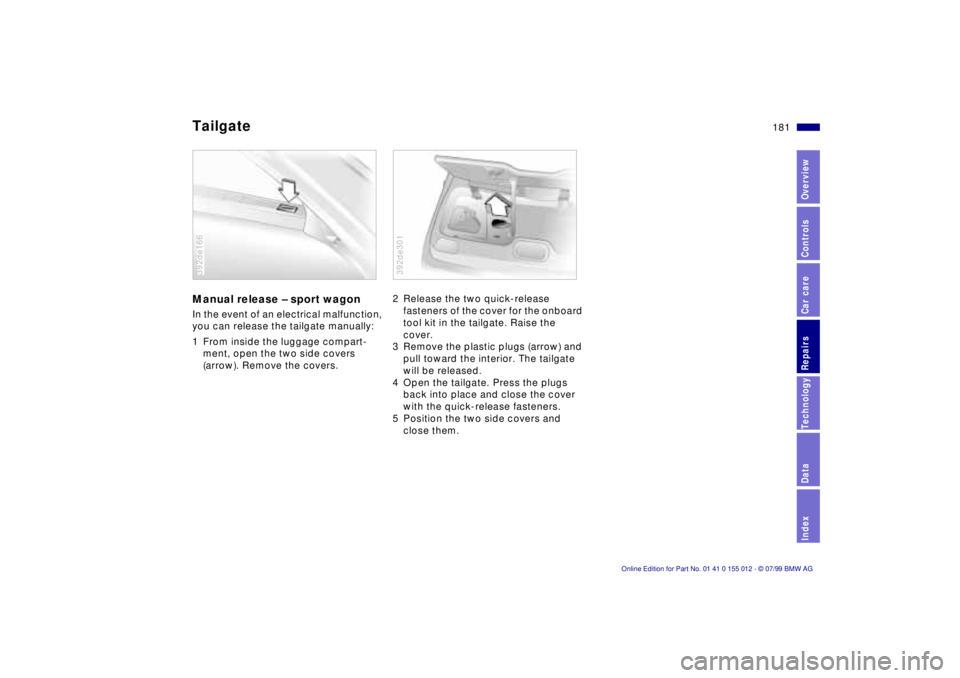
181n
RepairsIndexOverview Controls Car care Technology Data
Tailgate Manual release Ð sport wagon In the event of an electrical malfunction,
you can release the tailgate manually:
1 From inside the luggage compart-
ment, open the two side covers
(arrow). Remove the covers.392de166
2 Release the two quick-release
fasteners of the cover for the onboard
tool kit in the tailgate. Raise the
cover.
3 Remove the plastic plugs (arrow) and
pull toward the interior. The tailgate
will be released.
4 Open the tailgate. Press the plugs
back into place and close the cover
with the quick-release fasteners.
5 Position the two side covers and
close them.392de301
Page 182 of 217
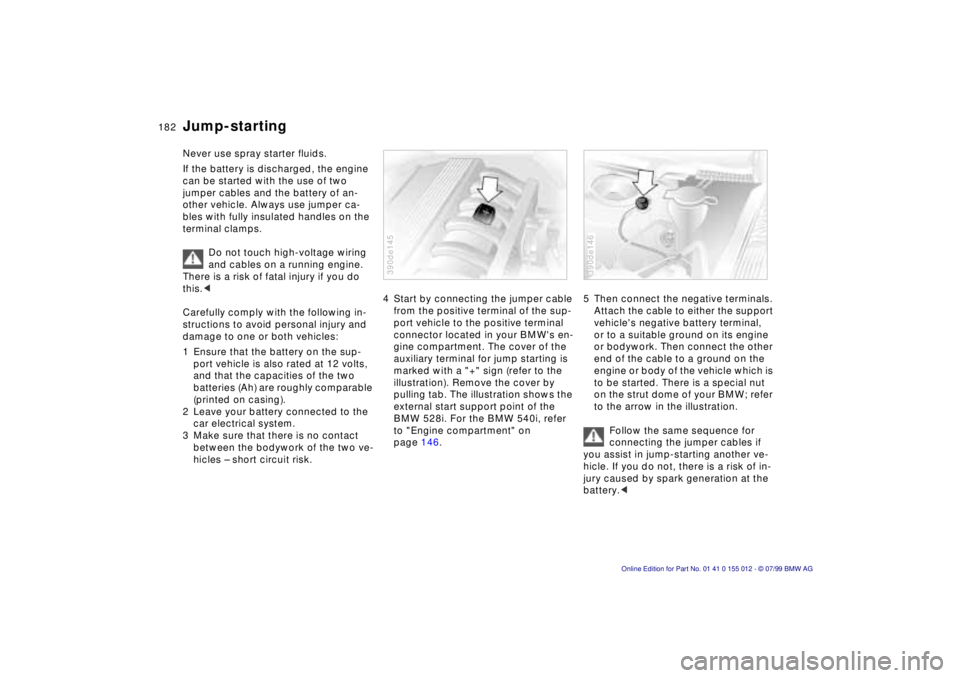
182n
Never use spray starter fluids.
If the battery is discharged, the engine
can be started with the use of two
jumper cables and the battery of an-
other vehicle. Always use jumper ca-
bles with fully insulated handles on the
terminal clamps.
Do not touch high-voltage wiring
and cables on a running engine.
There is a risk of fatal injury if you do
this.<
Carefully comply with the following in-
structions to avoid personal injury and
damage to one or both vehicles:
1 Ensure that the battery on the sup-
port vehicle is also rated at 12 volts,
and that the capacities of the two
batteries (Ah) are roughly comparable
(printed on casing).
2 Leave your battery connected to the
car electrical system.
3 Make sure that there is no contact
between the bodywork of the two ve-
hicles Ð short circuit risk.
4 Start by connecting the jumper cable
from the positive terminal of the sup-
port vehicle to the positive terminal
connector located in your BMW's en-
gine compartment. The cover of the
auxiliary terminal for jump starting is
marked with a "+" sign (refer to the
illustration). Remove the cover by
pulling tab. The illustration shows the
external start support point of the
BMW 528i. For the BMW 540i, refer
to "Engine compartment" on
page 146.390de145
5 Then connect the negative terminals.
Attach the cable to either the support
vehicle's negative battery terminal,
or to a suitable ground on its engine
or bodywork. Then connect the other
end of the cable to a ground on the
engine or body of the vehicle which is
to be started. There is a special nut
on the strut dome of your BMW; refer
to the arrow in the illustration.
Follow the same sequence for
connecting the jumper cables if
you assist in jump-starting another ve-
hicle. If you do not, there is a risk of in-
jury caused by spark generation at the
battery.< 390de146
Jump-starting
Page 183 of 217
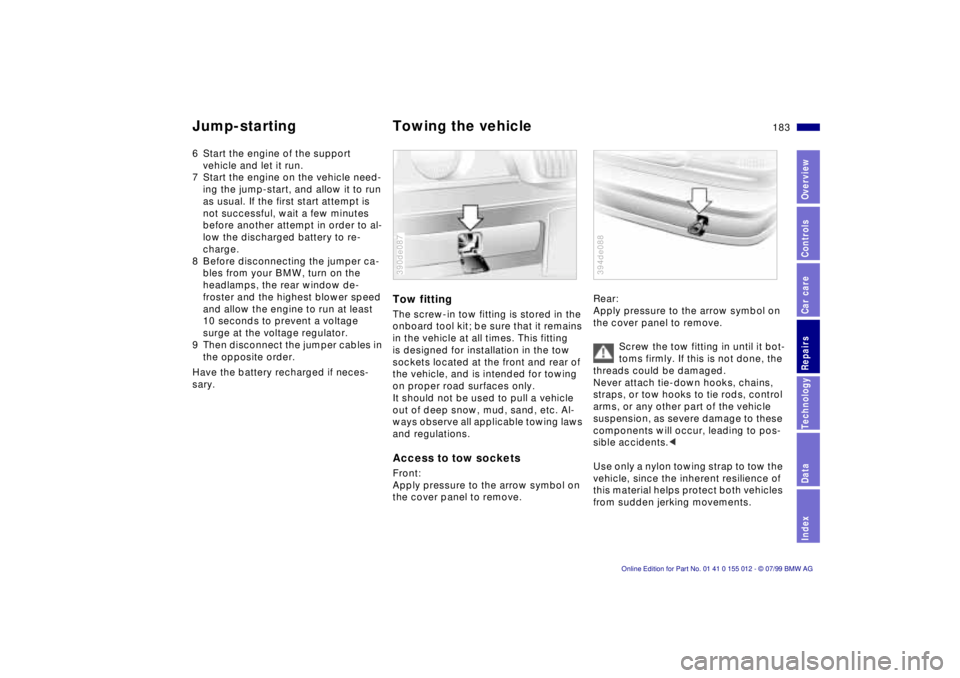
183n
RepairsIndexOverview Controls Car care Technology Data
Jump-starting Towing the vehicle 6 Start the engine of the support
vehicle and let it run.
7 Start the engine on the vehicle need-
ing the jump-start, and allow it to run
as usual. If the first start attempt is
not successful, wait a few minutes
before another attempt in order to al-
low the discharged battery to re-
charge.
8 Before disconnecting the jumper ca-
bles from your BMW, turn on the
headlamps, the rear window de-
froster and the highest blower speed
and allow the engine to run at least
10 seconds to prevent a voltage
surge at the voltage regulator.
9 Then disconnect the jumper cables in
the opposite order.
Have the battery recharged if neces-
sary.
Tow fittingThe screw-in tow fitting is stored in the
onboard tool kit; be sure that it remains
in the vehicle at all times. This fitting
is designed for installation in the tow
sockets located at the front and rear of
the vehicle, and is intended for towing
on proper road surfaces only.
It should not be used to pull a vehicle
out of deep snow, mud, sand, etc. Al-
ways observe all applicable towing laws
and regulations.Access to tow socketsFront:
Apply pressure to the arrow symbol on
the cover panel to remove.390de087
Rear:
Apply pressure to the arrow symbol on
the cover panel to remove.
Screw the tow fitting in until it bot-
toms firmly. If this is not done, the
threads could be damaged.
Never attach tie-down hooks, chains,
straps, or tow hooks to tie rods, control
arms, or any other part of the vehicle
suspension, as severe damage to these
components will occur, leading to pos-
sible accidents.<
Use only a nylon towing strap to tow the
vehicle, since the inherent resilience of
this material helps protect both vehicles
from sudden jerking movements.394de088
Page 184 of 217
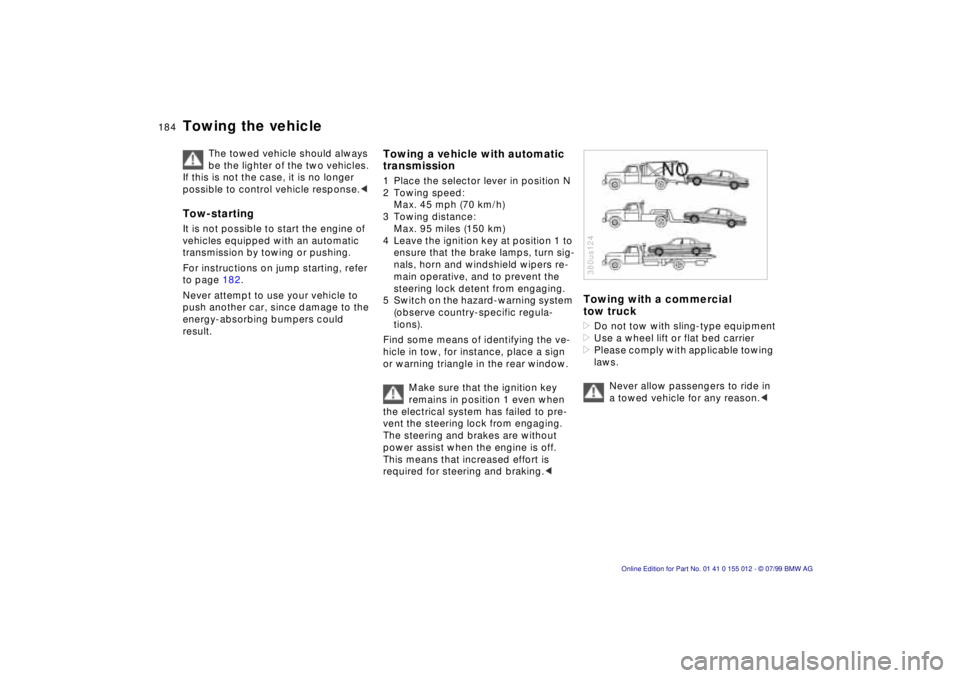
184n
Towing the vehicle
The towed vehicle should always
be the lighter of the two vehicles.
If this is not the case, it is no longer
possible to control vehicle response.<
Tow-startingIt is not possible to start the engine of
vehicles equipped with an automatic
transmission by towing or pushing.
For instructions on jump starting, refer
to page 182.
Never attempt to use your vehicle to
push another car, since damage to the
energy-absorbing bumpers could
result.
Towing a vehicle with automatic
transmission1 Place the selector lever in position N
2 Towing speed:
Max. 45 mph (70 km/h)
3 Towing distance:
Max. 95 miles (150 km)
4 Leave the ignition key at position 1 to
ensure that the brake lamps, turn sig-
nals, horn and windshield wipers re-
main operative, and to prevent the
steering lock detent from engaging.
5 Switch on the hazard-warning system
(observe country-specific regula-
tions).
Find some means of identifying the ve-
hicle in tow, for instance, place a sign
or warning triangle in the rear window.
Make sure that the ignition key
remains in position 1 even when
the electrical system has failed to pre-
vent the steering lock from engaging.
The steering and brakes are without
power assist when the engine is off.
This means that increased effort is
required for steering and braking.<
Towing with a commercial
tow truck>Do not tow with sling-type equipment
>Use a wheel lift or flat bed carrier
>Please comply with applicable towing
laws.
Never allow passengers to ride in
a towed vehicle for any reason.<380us124
Page 185 of 217
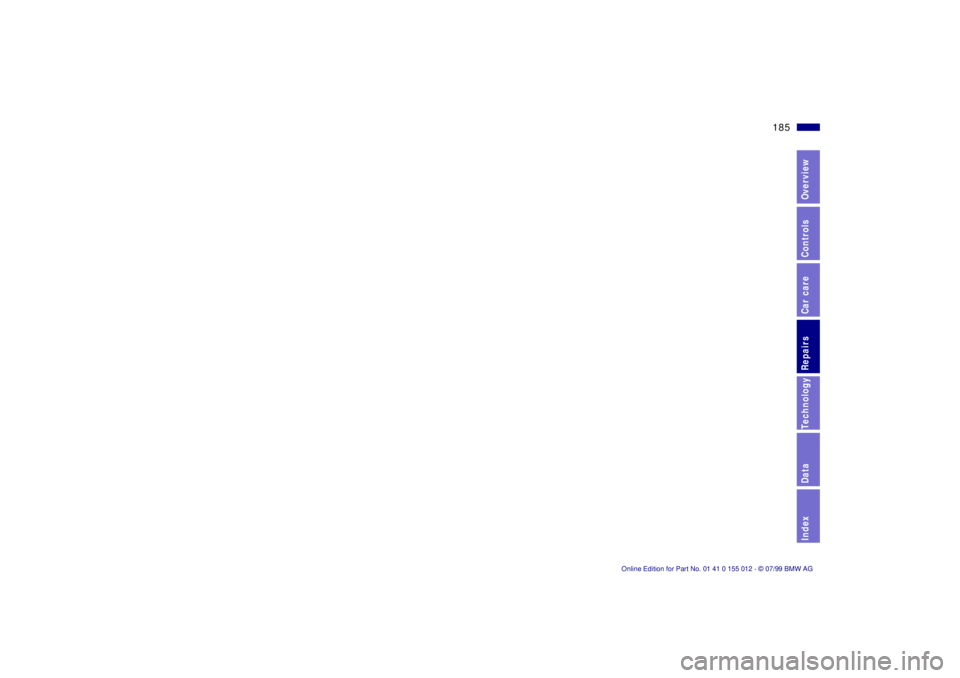
185n
RepairsIndexOverview Controls Car care Technology Data
Page 186 of 217
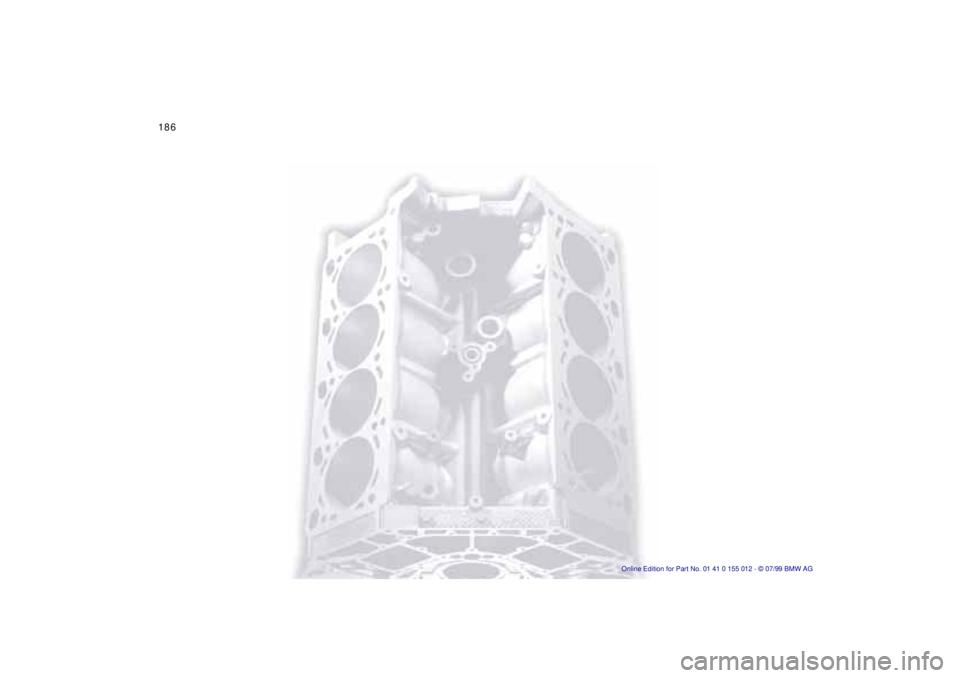
186n
Page 187 of 217
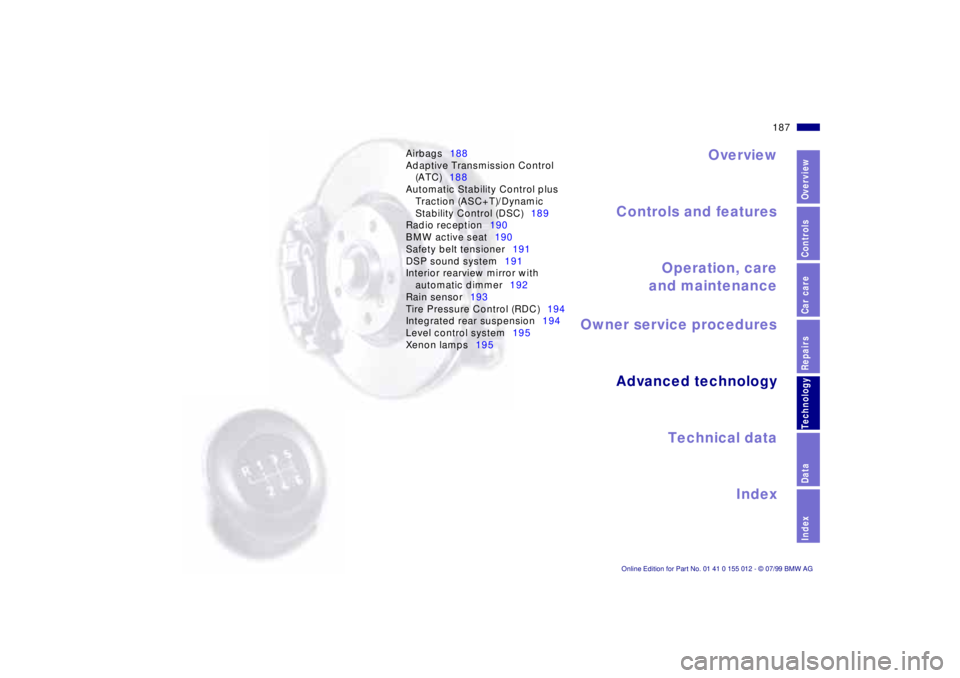
Overview
Controls and features
Operation, care
and maintenance
Owner service procedures
Technical data
Index Advanced technology
187n
RepairsIndexOverview Controls Car care Technology Data
Airbags188
Adaptive Transmission Control
(ATC)188
Automatic Stability Control plus
Traction (ASC+T)/Dynamic
Stability Control (DSC)189
Radio reception190
BMW active seat190
Safety belt tensioner191
DSP sound system191
Interior rearview mirror with
automatic dimmer192
Rain sensor193
Tire Pressure Control (RDC)194
Integrated rear suspension194
Level control system195
Xenon lamps195
Page 188 of 217
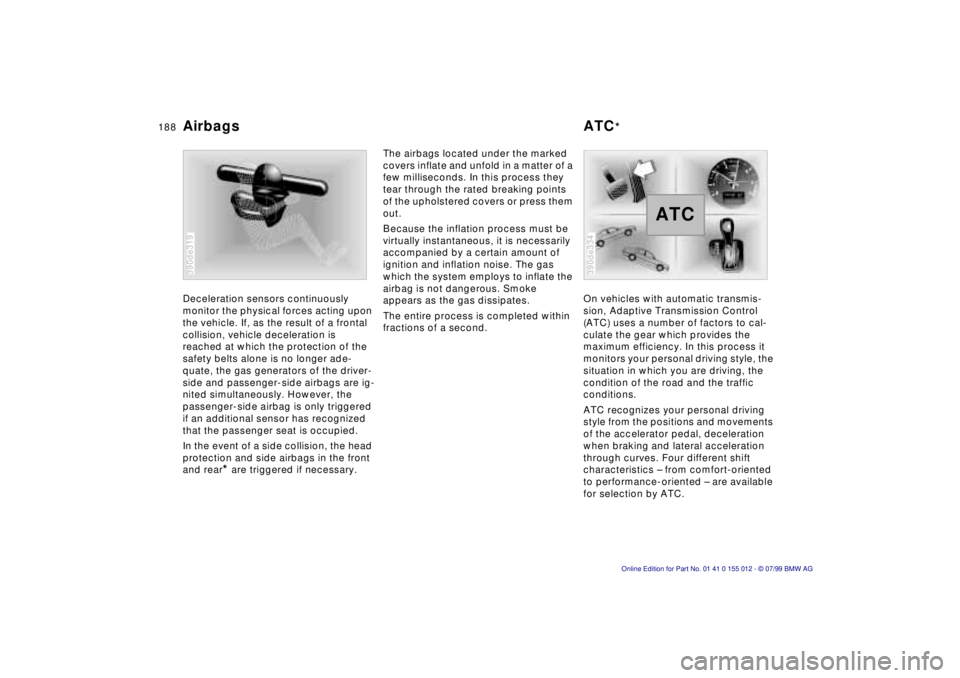
188n
Deceleration sensors continuously
monitor the physical forces acting upon
the vehicle. If, as the result of a frontal
collision, vehicle deceleration is
reached at which the protection of the
safety belts alone is no longer ade-
quate, the gas generators of the driver-
side and passenger-side airbags are ig-
nited simultaneously. However, the
passenger-side airbag is only triggered
if an additional sensor has recognized
that the passenger seat is occupied.
In the event of a side collision, the head
protection and side airbags in the front
and rear
* are triggered if necessary.
390de319
The airbags located under the marked
covers inflate and unfold in a matter of a
few milliseconds. In this process they
tear through the rated breaking points
of the upholstered covers or press them
out.
Because the inflation process must be
virtually instantaneous, it is necessarily
accompanied by a certain amount of
ignition and inflation noise. The gas
which the system employs to inflate the
airbag is not dangerous. Smoke
appears as the gas dissipates.
The entire process is completed within
fractions of a second.On vehicles with automatic transmis-
sion, Adaptive Transmission Control
(ATC) uses a number of factors to cal-
culate the gear which provides the
maximum efficiency. In this process it
monitors your personal driving style, the
situation in which you are driving, the
condition of the road and the traffic
conditions.
ATC recognizes your personal driving
style from the positions and movements
of the accelerator pedal, deceleration
when braking and lateral acceleration
through curves. Four different shift
characteristics Ð from comfort-oriented
to performance-oriented Ð are available
for selection by ATC.
390de334
ATC
Airbags ATC
*
Page 189 of 217
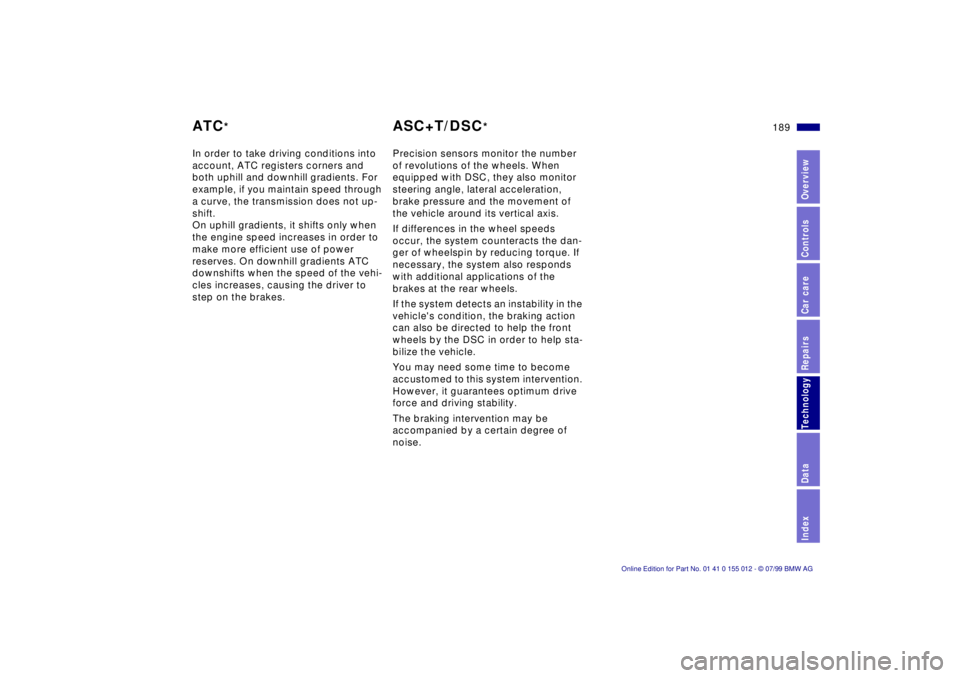
189n
RepairsIndexOverview Controls Car care Technology Data
In order to take driving conditions into
account, ATC registers corners and
both uphill and downhill gradients. For
example, if you maintain speed through
a curve, the transmission does not up-
shift.
On uphill gradients, it shifts only when
the engine speed increases in order to
make more efficient use of power
reserves. On downhill gradients ATC
downshifts when the speed of the vehi-
cles increases, causing the driver to
step on the brakes.Precision sensors monitor the number
of revolutions of the wheels. When
equipped with DSC, they also monitor
steering angle, lateral acceleration,
brake pressure and the movement of
the vehicle around its vertical axis.
If differences in the wheel speeds
occur, the system counteracts the dan-
ger of wheelspin by reducing torque. If
necessary, the system also responds
with additional applications of the
brakes at the rear wheels.
If the system detects an instability in the
vehicle's condition, the braking action
can also be directed to help the front
wheels by the DSC in order to help sta-
bilize the vehicle.
You may need some time to become
accustomed to this system intervention.
However, it guarantees optimum drive
force and driving stability.
The braking intervention may be
accompanied by a certain degree of
noise.ATC
*
ASC+T/DSC
*
Page 190 of 217
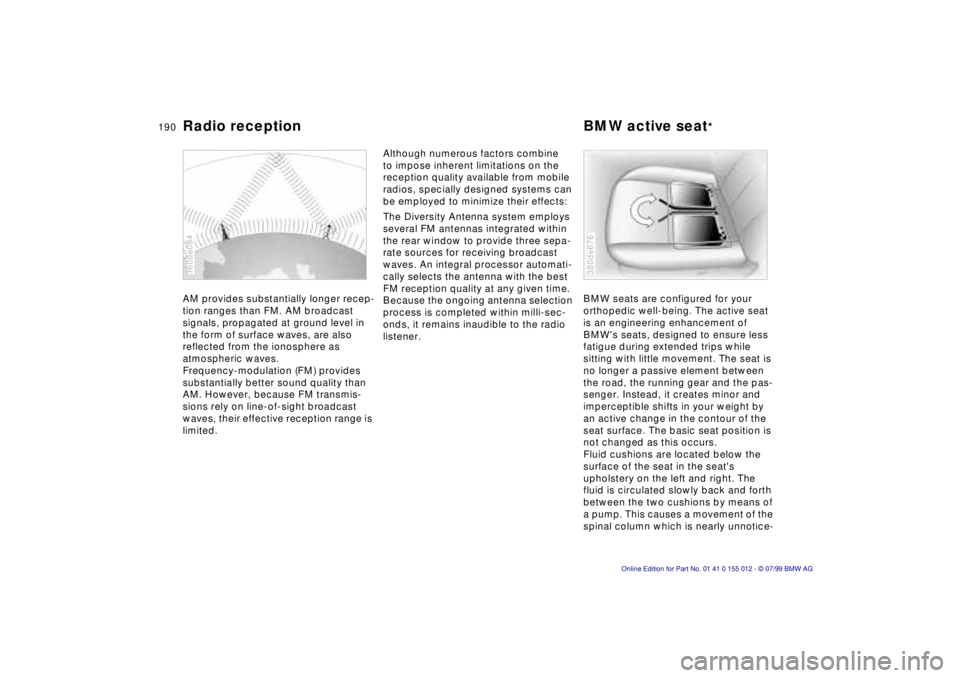
190n
Radio reception BMW active seat
*
AM provides substantially longer recep-
tion ranges than FM. AM broadcast
signals, propagated at ground level in
the form of surface waves, are also
reflected from the ionosphere as
atmospheric waves.
Frequency-modulation (FM) provides
substantially better sound quality than
AM. However, because FM transmis-
sions rely on line-of-sight broadcast
waves, their effective reception range is
limited.360de084
Although numerous factors combine
to impose inherent limitations on the
reception quality available from mobile
radios, specially designed systems can
be employed to minimize their effects:
The Diversity Antenna system employs
several FM antennas integrated within
the rear window to provide three sepa-
rate sources for receiving broadcast
waves. An integral processor automati-
cally selects the antenna with the best
FM reception quality at any given time.
Because the ongoing antenna selection
process is completed within milli-sec-
onds, it remains inaudible to the radio
listener.BMW seats are configured for your
orthopedic well-being. The active seat
is an engineering enhancement of
BMW's seats, designed to ensure less
fatigue during extended trips while
sitting with little movement. The seat is
no longer a passive element between
the road, the running gear and the pas-
senger. Instead, it creates minor and
imperceptible shifts in your weight by
an active change in the contour of the
seat surface. The basic seat position is
not changed as this occurs.
Fluid cushions are located below the
surface of the seat in the seat's
upholstery on the left and right. The
fluid is circulated slowly back and forth
between the two cushions by means of
a pump. This causes a movement of the
spinal column which is nearly unnotice-
380de676